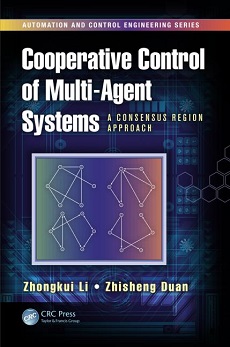内容简介:
Distributed controller design is generally a challenging task, especially for multi-agent systems with complex dynamics, due to the interconnected effect of the agent dynamics, the interaction graph among agents, and the cooperative control laws. Cooperative Control of Multi-Agent Systems: A Consensus Region Approach offers a systematic framework for designing distributed controllers for multi-agent systems with general linear agent dynamics, linear agent dynamics with uncertainties, and Lipschitz nonlinear agent dynamics.
● Explores the consensus control problem for continuous-time and discrete-time linear multi-agent systems
● Studies the H∞ and H2 consensus problems for linear multi-agent systems subject to external disturbances
● Designs distributed adaptive consensus protocols for continuous-time linear multi-agent systems
● Considers the distributed tracking control problem for linear multi-agent systems with a leader of nonzero control input
● Examines the distributed containment control problem for the case with multiple leaders
● Covers the robust cooperative control problem for multi-agent systems with linear nominal agent dynamics subject to heterogeneous matching uncertainties
● Discusses the global consensus problem for Lipschitz nonlinear multi-agent systems
Cooperative Control of Multi-Agent Systems: A Consensus Region Approach provides a novel approach to designing distributed cooperative protocols for multi-agent systems with complex dynamics. The proposed consensus region decouples the design of the feedback gain matrices of the cooperative protocols from the communication graph and serves as a measure for the robustness of the protocols to variations of the communication graph. By exploiting the decoupling feature, adaptive cooperative protocols are presented that can be designed and implemented in a fully distributed fashion.
英文目录:
Preface
1 Introduction and Mathematical Background
1.1 Introduction to Cooperative Control of Multi-Agent Systems
1.1.1 Consensus
1.1.2 Formation Control
1.1.3 Flocking
1.2 Overview of This Monograph
1.3 Mathematical Preliminaries
1.3.1 Notations and Definitions
1.3.2 Basic Algebraic Graph Theory
1.3.3 Stability Theory and Technical Tools
1.4 Notes
2 Consensus Control of Linear Multi-Agent Systems: Continuous-Time Case
2.1 Problem Statement
2.2 State Feedback Consensus Protocols
2.2.1 Consensus Condition and Consensus Value
2.2.2 Consensus Region
2.2.3 Consensus Protocol Design
2.3 Observer-Type Consensus Protocols
2.3.1 Full-Order Observer-Type Protocol I
2.3.2 Full-Order Observer-Type Protocol II
2.3.3 Reduced-Order Observer-Based Protocol
2.4 Extensions to Switching Communication Graphs
2.5 Extension to Formation Control
2.6 Notes
3 Consensus Control of Linear Multi-Agent Systems: Discrete-Time Case
3.1 Problem Statement
3.2 State Feedback Consensus Protocols
3.2.1 Consensus Condition
3.2.2 Discrete-Time Consensus Region
3.2.3 Consensus Protocol Design
3.3 Observer-Type Consensus Protocols
3.3.1 Full-Order Observer-Type Protocol I
3.3.2 Full-Order Observer-Type Protocol II
3.3.3 Reduced-Order Observer-Based Protocol
3.4 Application to Formation Control
3.5 Discussions
3.6 Notes
4 H∞ and H2 Consensus Control of Linear Multi-Agent Systems
4.1 H∞ Consensus on Undirected Graphs
4.1.1 Problem Formulation and Consensus Condition
4.1.2 H∞ Consensus Region
4.1.3 H∞ Performance Limit and Protocol Synthesis
4.2 H2 Consensus on Undirected Graphs
4.3 H∞ Consensus on Directed Graphs
4.3.1 Leader-Follower Graphs
4.3.2 Strongly Connected Directed Graphs
4.4 Notes
5 Consensus Control of Linear Multi-agent Systems Using Distributed Adaptive Protocols
5.1 Distributed Relative-State Adaptive Consensus Protocols
5.1.1 Consensus Using Edge-Based Adaptive Protocols
5.1.2 Consensus Using Node-Based Adaptive Protocols
5.1.3 Extensions to Switching Communication Graphs
5.2 Distributed Relative-Output Adaptive Consensus Protocols
5.2.1 Consensus Using Edge-Based Adaptive Protocols
5.2.2 Consensus Using Node-Based Adaptive Protocols
5.2.3 Simulation Examples
5.3 Extensions to Leader-Follower Graphs
5.4 Robust Redesign of Distributed Adaptive Protocols
5.4.1 Robust Edge-Based Adaptive Protocols
5.4.2 Robust Node-Based Adaptive Protocols
5.4.3 Simulation Examples
5.5 Distributed Adaptive Protocols for Graphs with Directed Spanning Trees
5.5.1 Distributed Adaptive Consensus Protocols
5.5.2 Robust Redesign in the Presence of External Disturbances
5.6 Notes
6 Distributed Tracking of Linear Multi-Agent Systems with a Leader of Possibly Nonzero Input
6.1 Problem Statement
6.2 Distributed Discontinuous Tracking Controllers
6.2.1 Discontinuous Static Controllers
6.2.2 Discontinuous Adaptive Controllers
6.3 Distributed Continuous Tracking Controllers
6.3.1 Continuous Static Controllers
6.3.2 Adaptive Continuous Controllers
6.4 Distributed Output-Feedback Controllers
6.5 Simulation Examples
6.6 Notes
7 Containment Control of Linear Multi-Agent Systems with Multiple Leaders
7.1 Containment of Continuous-Time Multi-Agent Systems with Leaders of Zero Inputs
7.1.1 Dynamic Containment Controllers
7.1.2 Static Containment Controllers
7.2 Containment Control of Discrete-Time Multi-Agent Systems with Leaders of Zero Inputs
7.2.1 Dynamic Containment Controllers
7.2.2 Static Containment Controllers
7.2.3 Simulation Examples
7.3 Containment of Continuous-Time Multi-Agent Systems with Leaders of Nonzero Inputs
7.3.1 Distributed Continuous Static Controllers
7.3.2 Adaptive Continuous Containment Controllers
7.3.3 Simulation Examples
7.4 Notes
8 Distributed Robust Cooperative Control for Multi-Agent Systems with Heterogeneous Matching Uncertainties
8.1 Distributed Robust Leaderless Consensus
8.1.1 Distributed Static Consensus Protocols
8.1.2 Distributed Adaptive Consensus Protocols
8.2 Distributed Robust Consensus with a Leader of Nonzero Control Input
8.3 Robustness with Respect to Bounded Non-Matching Disturbances
8.4 Distributed Robust Containment Control with Multiple Leaders
8.5 Notes
9 Global Consensus of Multi-Agent Systems with Lipschitz Nonlinear Dynamics
9.1 Global Consensus of Nominal Lipschitz Nonlinear Multi-Agent Systems
9.1.1 Global Consensus without Disturbances
9.1.2 Global H1 Consensus Subject to External Disturbances
9.1.3 Extensions to Leader-Follower Graphs
9.1.4 Simulation Example
9.2 Robust Consensus of Lipschitz Nonlinear Multi-Agent Systems with Matching Uncertainties
9.2.1 Distributed Static Consensus Protocols
9.2.2 Distributed Adaptive Consensus Protocols
9.2.3 Adaptive Protocols for the Case without Uncertainties
9.2.4 Simulation Examples
9.3 Notes
Bibliography
Index

